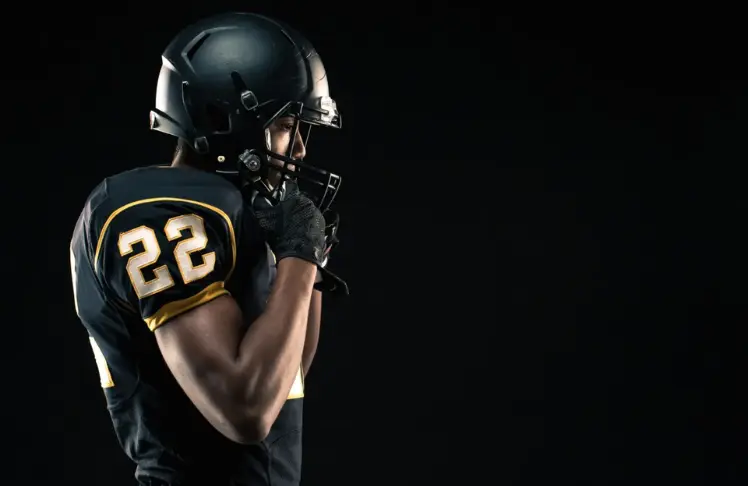
Sports is a sanctuary for young Black athletes.
But behind the victories and million-dollar contracts, Black athletes often go unnoticed when it comes to their mental health.
“I don’t think people understand the situations where a lot of these athletes come from,” Doug Middleton, a former NFL safety, says. “Sports is like our therapy.”
Middleton knows all too well what can happen when Black athletes don’t have the support they need to cope with the pressures of life.
In his second year with the New York Jets, his best friend, AJ, died by suicide. Although Middleton was raised by a mom who worked as a licensed counselor, it wasn’t until AJ’s suicide that he became more knowledgeable about the importance of taking care of your mental health.
“His passing was more about the awareness and light that it brought to things that may have been on the wayside for me,” he says. “I was always around mental health … but I never really understood it to that level.”
Naomi Osaka, Simone Biles, and Noah Lyes are some of the most recognizable Black athletes who have spoken about their mental health struggles. And broader efforts to shift the conversation about Black athlete mental health are happening — and are necessary.
Now, as a newly retired NFL player, Middleton is part of a movement to raise awareness about how Black athletes may struggle with their mental health. In 2017, he founded Dream The Impossible, a mental health awareness nonprofit. He’s more outspoken than ever about the internal pressures many athletes experience and is adamant about helping Black youth take care of their mental health.
“The same things that make you a great athlete are the same things that can also cause a burden to you,” he says.
The Toll Athletes Face
In a 10-year national survey conducted by the Centers for Disease Control and Prevention, the rates of suicidal thoughts and behaviors increased. In 2021, Black students were more likely than Asian, Hispanic, and white students to attempt suicide. According to the Youth Risk Behavior report, American Indian or Alaska Native and Black high school students reported the highest rates of attempted suicides — 16% and 14%, respectively.
There isn’t specific data available about Black high school athletes, but the pressure to perform at a high enough level to win state championships and get a spot on a college team starts to take a toll.
Vic Armstrong, vice president for health equity at the American Foundation for Suicide Prevention, says the more players talk about and value their own mental health, the more it’ll become a priority for the teams they play on. Recently, Angel Reese spoke up about needing to take a break from the spotlight to care for her mental health.
“The things they’re asked to do, to set aside their own personal well-being, and sacrifice for the well-being of the team — you are seeing more and more athletes speak out about the challenges they’re facing,” Armstrong says. “I think that, in turn, puts pressure on the teams to respond to it.”
Part of the cascade of pressure that Black athletes face is being the first in the family to provide generational wealth for generations to come, he says. Although athletes may sign million-dollar contracts, oftentimes, the money goes towards paying bills, caring for family members, and paying off debts.
“They may not have the luxury to pass on a million dollars to transfer to another school because their family needs the money. So, they’re making decisions for very different reasons, which is going to have a lot of impact on their mental well-being,” Armstrong says. “What happens if your family’s hopes and dreams rest on your success as a professional athlete?
To deal with that pressure, it’s important to teach young people how to be vulnerable, what it means to feel lonely, and how to cope with those feelings. It’s critical that parents and adults start these conversations with young people so they know how to manage their emotions — before reaching a point of suicidality.
Although young people experience suicidal thoughts for different reasons, one thing that is missing is the nuances of race, culture, and ethnicity. At AFSP, Armstrong is working to center Black voices in the mental health conversation and create a safe space for them.
As for solutions to help Black athletes navigate their mental health, Middleton and Armstrong have three main suggestions:
- Develop community. A lot of people just want to feel seen and appreciated. By developing that community, it can help deter suicidal ideations.
- Invest in your future self. Practicing yoga, self-care, and/or going to therapy are practical ways to check in with your mental health.
- Normalize the conversation. Despite the taboo of talking about mental health in the Black community, starting these conversations is more important than ever.
If you’re feeling suicidal or concerned that someone you know may be in danger of hurting themselves, call or text the National Suicide Prevention Lifeline at 988. The lifeline is available 24 hours a day, seven days a week, and is staffed by trained counselors















